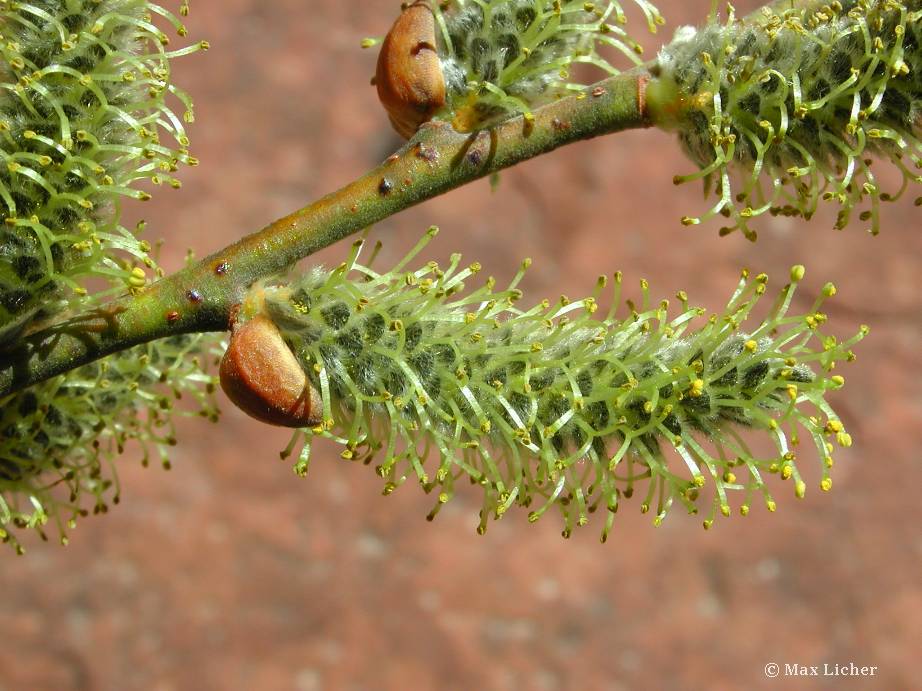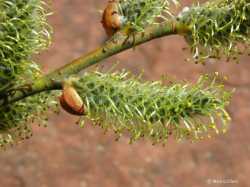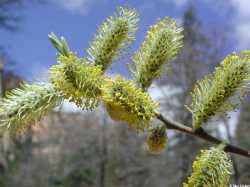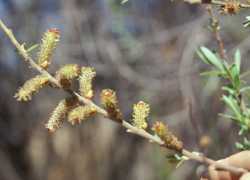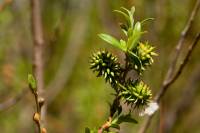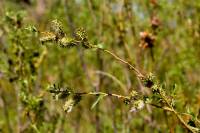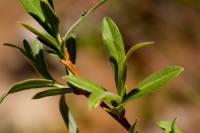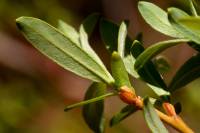Shrubs or trees, 1.5-10 m, (sometimes forming clones by stem fragmentation). Stems: branches (sometimes flexible to highly brittle at base), yellow-brown to red-brown, not or weakly glaucous, glabrous, tomentose, pubescent (appearing dusty); branchlets yellowish, yellow-brown, or red-brown, sparsely to densely villous, tomentose, or velvety to glabrescent, (inner membranaceous bud-scale layer free, separating from outer layer). Leaves: stipules usually foliaceous, or rudimentary or absent on early ones, foliaceous on late ones, apex acute; petiole convex to flat, or shallowly grooved adaxially, 3-16 mm, tomentose or velvety adaxially; largest medial blade lorate, narrowly oblong, narrowly elliptic, oblanceolate, or obovate to broadly obovate, 36-125 × 6-32 mm, 1.9-9.6 times as long as wide, base cuneate or convex, margins slightly to strongly revolute, entire or remotely or irregularly serrate, sinuate, (glands submarginal or epilaminal), apex acute, acuminate, convex or rounded, abaxial surface glaucous, sparsely pubescent, moderately densely tomentose or woolly-tomentose, short- or long-silky to glabrescent, hairs (white, sometimes also ferruginous), wavy, adaxial slightly or highly glossy, moderately densely tomentose or short-silky to glabrescent, (hairs white, sometimes also ferruginous); proximal blade margins entire or serrulate; juvenile blade color sometimes obscured by hairs, silky, tomentose or very densely woolly-tomentose abaxially, hairs white, sometimes ferruginous. Catkins flowering before or just before leaves emerge; staminate slender or stout, 18-88 × 5-15 mm, flowering branchlet 0-5 mm; pistillate densely flowered, slender or stout, 18-72 × 7-12 mm, flowering branchlet 0-6 mm; floral bract 1-2.4 mm, apex broadly rounded, abaxially hairy, hairs straight or wavy. Staminate flowers: adaxial nectary narrowly oblong, oblong, or ovate, 0.5-1.2 mm; filaments distinct or connate less than 1/2 their lengths; anthers purple turning yellow, ellipsoid or shortly cylindrical, 0.4-0.7 mm. Pistillate flowers: adaxial nectary oblong to flask-shaped, 0.2-1.1 mm; stipe 1-1.7 mm; ovary pyriform, beak slightly bulged below styles; ovules 10-18 per ovary; styles (sometimes slightly distinct distally), 0.1-0.6 mm; stigmas flat, abaxially non-papillate with rounded or pointed tip, or 2 plump lobes, 0.1-0.3 mm. Capsules 2.5-5.5 mm. 2n = 76.
Flowering mid Jan-mid Jun. Streamshores, marshes, meadows, springs, coastal headlands, rocky bluffs, sand dunes, salt marshes, silty, sandy, gravelly, or rocky substrates, dolomite; 0-2800 m; Ariz., Calif., Idaho, Nev., N.Mex., Oreg., Tex., Utah, Wash.; Mexico (Baja California, Chiapas, Chihuahua, Coahuila, Durango, San Luis Potosí, Sonora).
Salix lasiolepis is polymorphic. Variety bigelovii has been recognized in coastal California and Oregon (G. W. Argus 1993). It differs mainly in density of leaf indumentum and in having leaves tending to be slightly broader; it may be a coastal ecotype and is not formally recognized here.
Hybrids:
Salix lasiolepis forms natural hybrids with S. irrorata and S. breweri. Hybrids with S. hookeriana are suspected but unconfirmed. The distinctly serrate leaves in some specimens from Arizona and New Mexico may be part of the species variability, but could also be due to hybridization.
Plant: Dioecious shrub; to 6 m tall; clonal; branches yellow- or red-brown, tomentose becoming glabrous; branchlets yellowish to red-brown, villous, tomentose, or velvety becoming glabrous
Leaves: stipules lacking to leaflike; petioles tomentose or velvety becoming glabrous, 3-16 mm long; young leaves silky to tomentose; mature blade ligulate to narrowly oblong, narrowly elliptic, or oblanceolate to obovate, 36-125 mm long, 6-32 mm wide, 3.2-9.6 times as long as wide, the lower surface glaucous, sparsely or densely tomentose or silky becoming glabrous, the hairs white or white and rust-colored, the upper surface glossy, tomentose or short-silky becoming glabrous, the base cuneate to acute, the margins slightly revolute, entire, gland-dotted, or remotely and irregularly serrate (undulating), with 2-4 teeth or glands per cm, the apices acute to obtuse
INFLORESCENCE: cylindrical to subspherical catkins; precocious to subprecocious; catkins sessile, flowering branchlets sometimes to 5 mm long; floral bracts dark brown, 1.2-2.4 mm with straight or wavy hairs, the apices rounded
Flowers: STAMINATE FLOWERS in densely flowered catkins 17-55 mm long; stamens 2; filaments glabrous; nectary slender to ovate, 0.5-1.2 mm long. PISTILLATE FLOWERS in densely flowered catkins 15-60 mm long; ovaries glabrous; stigmas 0.12-0.28 mm long; styles 0.1-0.6 mm long; stipes 0.5-2.4 mm long; nectary broad, 0.2-0.9 mm long, shorter than stipe
Fruit: lanceolate to ovate
Misc: thickets along rivers and creeks, marshes, meadows, springs, and rocky bluffs; 1200-2600 m (3900-8000 ft); Mar-May
REFERENCES: Argus, George W. 1995. SalicaceaePart 2. Salix. J. Ariz. - Nev. Acad. Sci. 29(1): 39
Common Name: arroyo willow
Duration: Perennial
Nativity: Native
Lifeform: Tree
Wetland Status: FACW
General: Deciduous multi-stemmed shrub reaching 6 m tall, stems yellow to red-brown, tomentose becoming glabrous; branchlets yellowish to red-brown, villous, tomentose, or velvety.
Leaves: Stipules lacking to leaflike; petioles tomentose or velvety becoming glabrous, 3-16 mm long; young leaves silky to tomentose, mature blade ligulate to narrowly oblong, narrowly elliptic; thick leaves, wider at time than at base, 4-10 cm long and 8-15 cm wide, upper surface dark green and shiny, lower surface is commonly pale or whitish, margins finely toothed to entire.
Flowers: Catkins sessile, reddish to black, hairless and shiny; 2.5-6 cm long.
Fruits: Capsule reddish-brown to dark green and hairless, 3-8 mm long with many cottony seeds.
Ecology: Found in thickets along rivers, creeks, marshes, and meadows from 4,000-8,000 ft (1219-2438 m); flowers March-May.
Notes: Distinguished by the leaves being ligulate to narrowly oblong, sometimes oblanceolate, about 3-10 times as long as wide; the floral bracts are rounded, and densely hairy all over.
Ethnobotany: Infusion of bark used for colds, for diarrhea, for itching, for chills and fever, for measles, while the bark was used in rope making, for garments, it was used for thatching, for basketry, as a chew, for fuelwood, and as a protective planting.
Etymology: Salix is the Latin name for willow, meaning -to leap or spring-, while lasiolepis means woolly-scaled.
Synonyms: None
Editor: SBuckley, 2010


